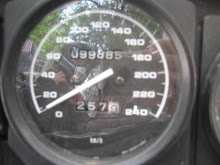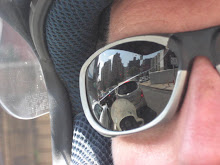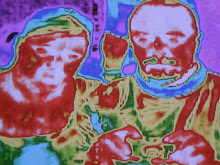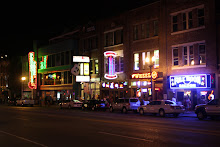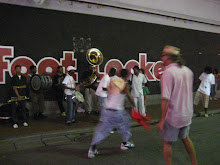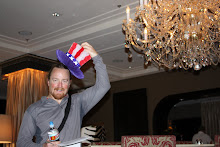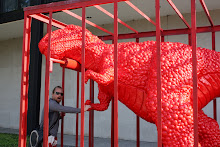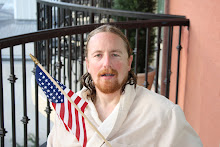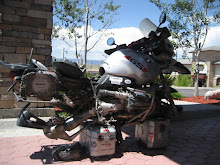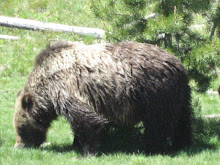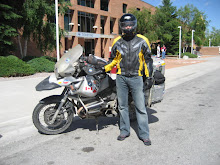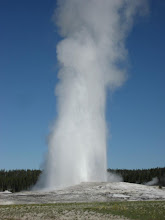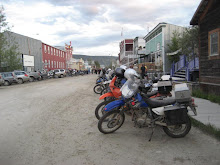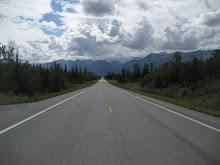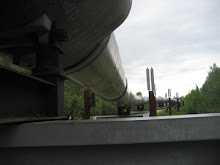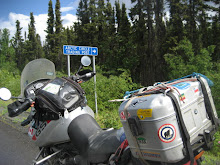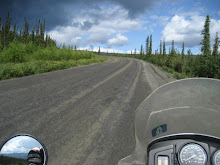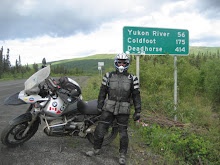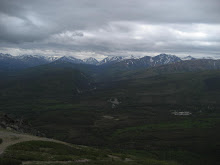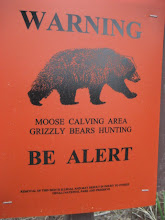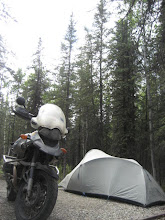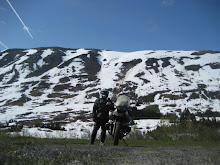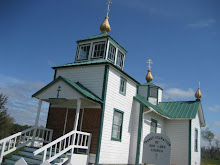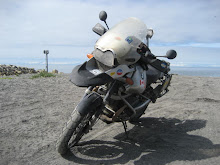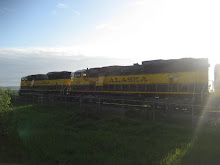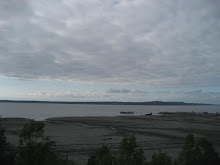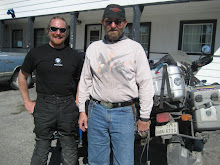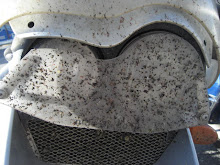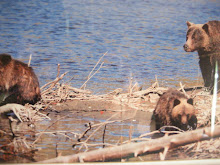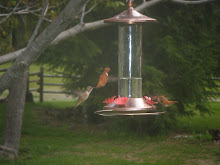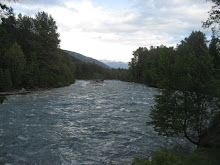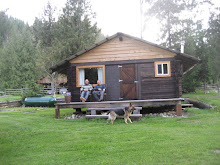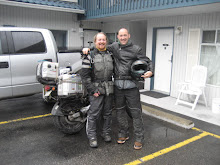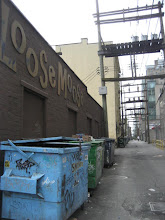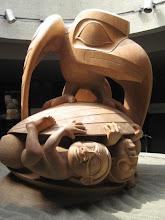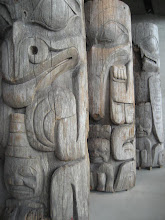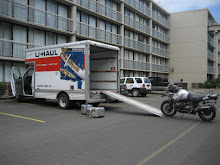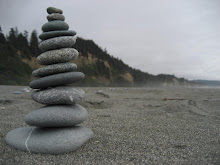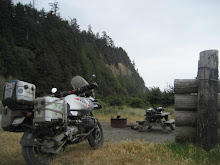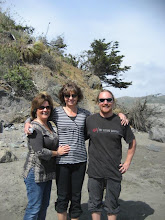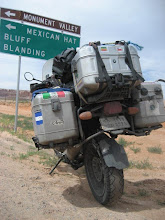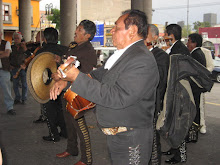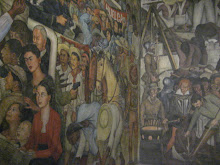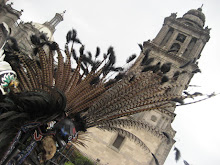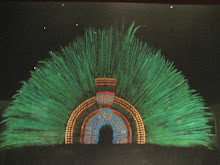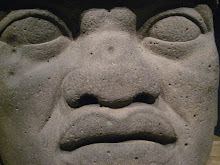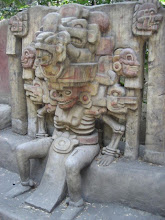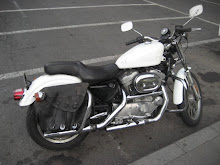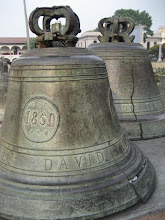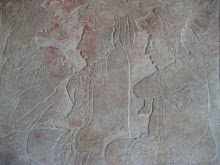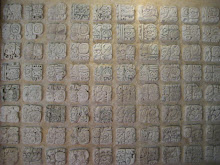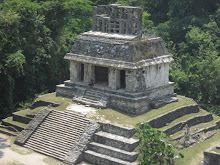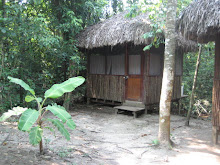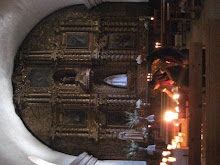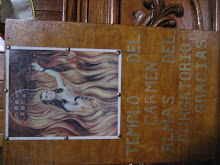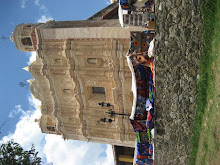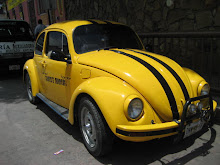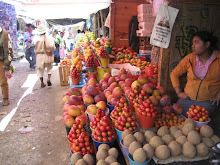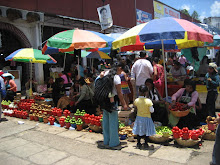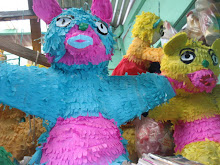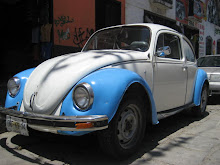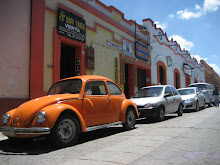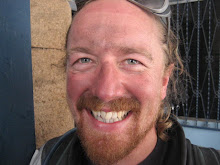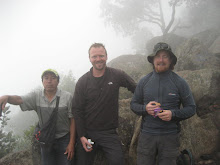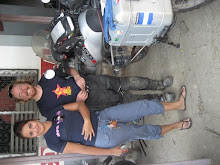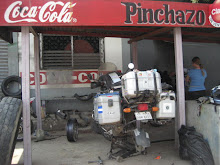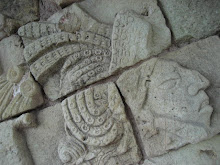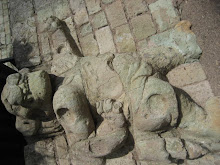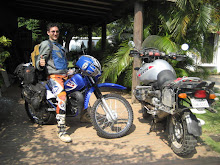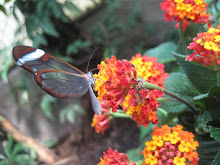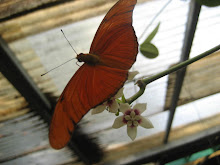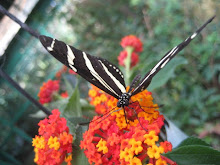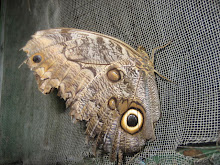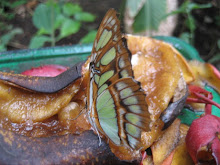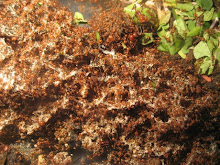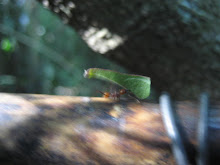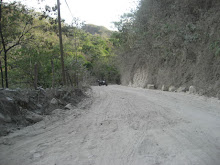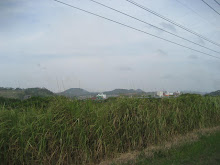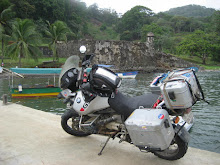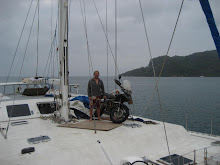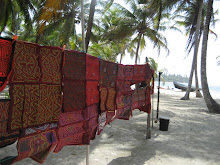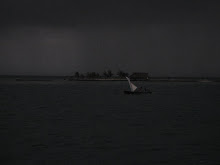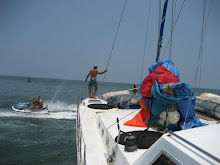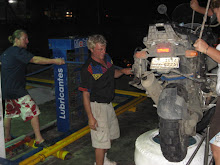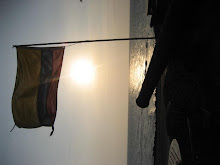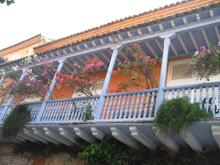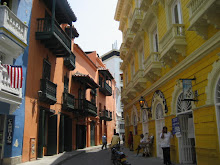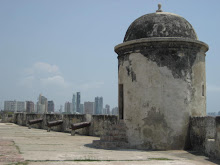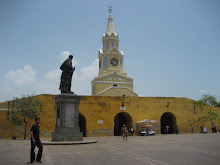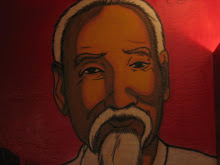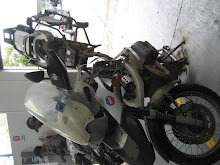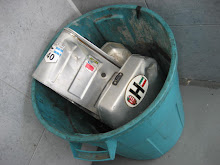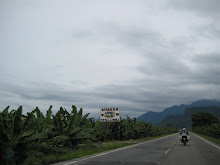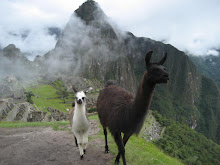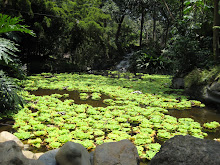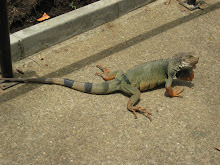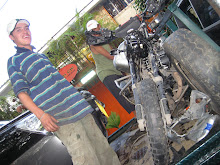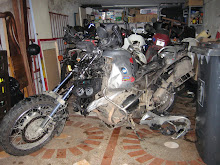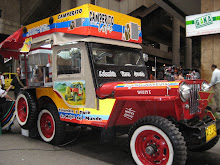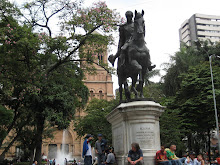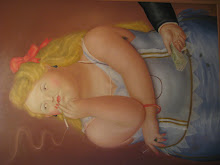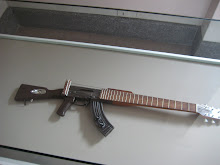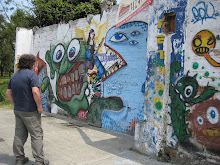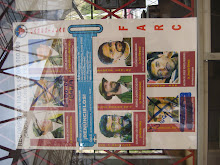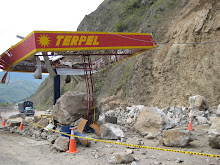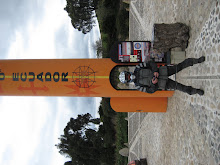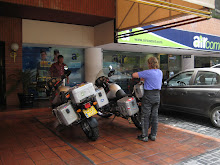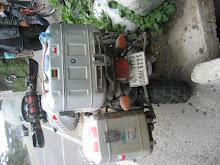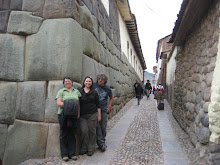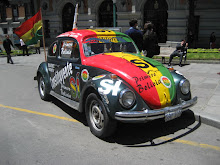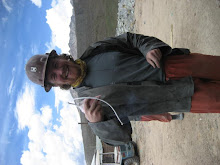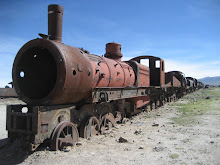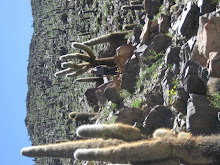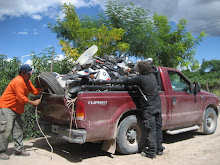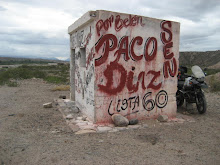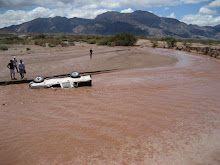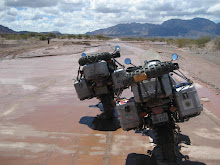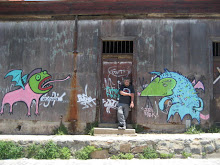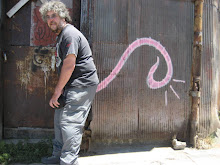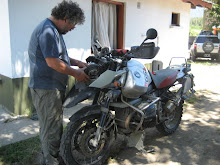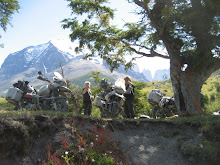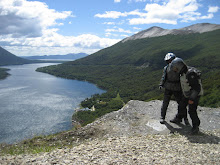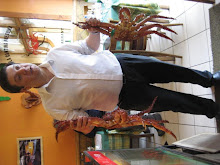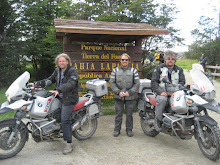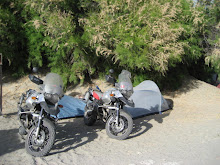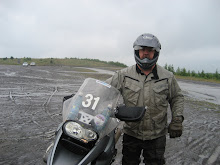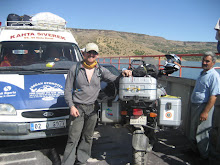Last night I read a quote by Machiavelli and resolved to have a go at riding on the Salar, as fortune favours the brave and one of the themes of this journey has been about the conquest of fear. The Florentine Humanist said, "it is better to be impetuous than cautious, because fortune is a woman, and it is necessary, if one wishes to hold her down, to beat her and fight with her", which is perhaps a very mediterranean perspective on these themes. Bike was fully charged, without luggage and had still new tyres, with the grip enhanced by the low pressure for getting through the deep sand. However, when I started the engine, a fuel leak became apparent from one of the fuel lines, I guess this was because the clip holding the hose to the tank outlet pipe had become worn from repeatedly being removed to re-fuel Arthur on the way to Rio Gallegos and to stock up our fuel cooker, as Neil has some special clip thing on his, which means we have been using mine for this. Still, with my new resolve to overcome all my fears, in particular about all the things that could go wrong with my bike, a small cable tie, pulled tight, does the job and the leak is fixed. I get out on the track from Uyuni north towards Colchani, where I had managed to gather from the maps and people in the tour offices, that most of the 4x4 entered the Salar. I turned west onto a spit of hardened sand with a glittering crust of salt, sparkling in the low morning sun. It was cold and crunchy under the tyres and so the scene looked and felt like riding on snow. The Spit ends after a few kilometres and by now I am surrounded by an endless flat expanse of glittering white, with the surrounding mountains, some of them must be hundreds of kilometres away, seemingly floating on the haze of light at the horizon, showing so clearly in the salt - dried air, which doesn't have any humidity in it at all. Ahead, I can see the Isla de Pescadores apparently suspended above the horizon, like the pyramid on the back of a one dollar note, and decide to head for it. Initially the tyres grip well on the crystalline surface and my confidence and speed begins to build and I can see why most landspeed records are attained on salt flats as I start to touch 175kph, my fastest on this trip so far. Then, slowly but steadily I sense a growing perception of a drag and wobble at the back wheel. I sit up from my crouch over the tank and hear a distinctly liquid rush around me as I see that the surface around me is cracking and the tyres are breaking the surface of the salt flat. Great gobs of sandy, salty mush are thrown up around me and I speed up again and make a wide, sweeping arc, passing 2 4x4 stuck in the slush, turn 180 degrees and head back to the firmer surface of Colchani and its surrounding small islands and salt processing equipment on the shore, feeling my heart beating through my jacket.
Relieved and exhilerated, I return to the hotel, pack my luggage onto the bike and crack on to Potosi, which took more than 5 hours to do just over 200km - through flood water, deep sand and rough mountain terrain. I was tired by the slow progress, constant concentration and the altitude too, as I reach the world's highest city at 4070m. Parked bike in the lobby of Hotel Turistic, where they literally put guests first, happily letting my bike dominate their reception and guiding me over the steps and through the narrow door. As a result of my bike being in such a prominent position, I met Christian, a German owner of a bike shop, and we had a good conversation over a couple of Potosi Pilseners. The town is dominated by the Cerro Rico, a mountain where 18m tonnes of refined silver alone where extracted during the colonial period, with the harsh conditions, use of mercury to refine the ore and the effects of altitude were responsible for more than 8 m deaths of African slaves and indigenous workers, a holocaust I had never heard of previously. To illustrate the scale of this, the Sydney Harbour Bridge Consists of just over 50,000 tonnes of steel, so an equivalent weight of silver would be the same as 360 Sydney Harbour Bridges made of the silver exported from Potosi's Cerro Rico, let alone the other precious metals found there. Now mostly Zinc, Lead and Tin are extracted from the "completo", mixed ore which is now extracted, still mostly by hand, from the now co-operative mines. I visited the Miners Market and picked up a tout for a team of mineros, and bought essential supplies - dynamite (17 Bs), coca leaves (5 Bs) and some bottles of refrescos and Ceiga, 95% proof hooch that is apparently only drunk on Fridays in honour of El Tio, the devil who is revered as the primary deity inside the mines. Pablo, the leader took me under his wing, and gave me some light duties within his cooperative of 45 mineros, winching up to the higher levels, pushing carraiges of ore and shovelling. The cooperative had bought an electrical winch, but all the rest of the work was done by hand, up inside the mountain at 4,500m above sea level. It was dusty and hot, and after a couple of hours I was also dizzy with altitude as the mine is uphill from the city, inside the Cerro Rico. As the days work came to an end, we set charges into the face, consisting of dynamite, nitrate and the fuse. I was allowed to light the fuses and we hurried up through the low tunnels to the high exit, hearing and feeling the thuds of the explosions as we left. Even more fun, I was allowed to set and let of another explosion on the surface, and to see and feel the power of the bomb, costing just over 1 GBP, was exhilerating and later more thought - provoking. Casa de Moneda was also an interesting visit, to the place where the precious metals were processed into coins and ingots.
The ride to La Paz started out well, luckily after I had got full pressure in my tyres for the first section to Challapata, which was full of nice sweeping corners on TARMAC, an interesting new surface for me, which, overall I found quite agreeable. After that, the roads became straighter and less interesting, particularly the sections around Oruro, which was one of the ugliest cities I had been through so far on this trip, an impression aggravated by the complete lack of signs and a consequent waste of time getting lost and contradictory directions. It was interesting, however, to see the Inca terraces still clearly visible on the road to La Paz, some of them still in use and highlighting the relative economic strength of the Pre - Colombian empire and the current nation of Bolivia, the poorest in South America. Suffering from drought in the West as its glaciers melt, floods in the east due to El Nina and the ongoing Coca Wars. There were stunning views on the cold, approach to La Paz, with snow - capped mountains as a backdrop contrasting against the autopista at El Alto (South Americas fastest growing slum) and the dirty slurry running down the streets. El Alto is a grim collection of halfbuilt shacks clinging to the cliffs of the gulch of the Rio Choqueyapu, on which La Paz is built. El Paz looks great from the edge of the gorge, and I sweep down into the Valley of the Moon. Oddly enough, although this is the only place where I have seen many Hispanic Bolivianos, the richer areas of the city are downhill and downstream from the rest of the city - although there is more pollution and less fresh air further down. I had to be careful when enjoying the view, as occasional enormous potholes on the autopista which corkscrews downwards at an invigorating angle, especially as it contains manic minibuses, brightly coloured buses and potholes which could literally swallow you up. I did wonder what the road toll money that I had just paid was actually spent on? I get into a luxury room at the Hotel Sagarnaga, for less than 10 pounds with breakfast and off street parking for my bike. There is a cool, cloudy atmosphere, but great for walking although you can feel the altitude as you stroll around the steep streets. La Paz is a dirty principle city in the poorest country in Latin America, but occasionally, when the curtains of the clouds are drawn by the breeze, vertiginous views are revealed which transcend the bleak streat life, e.g. of men and women crouching in the streets, going to toilet, something I have only ever seen in poor parts of southern India before. The witches market was interesting, with lots of strange dried animals for sacrificial rites - llama foetuses and armadilloes seemed the favoured species - along with lots of quck cures for male baldness and impotence. More comforting, was the Berlin Cafe, an old style cafe-bar which I visited a few times and enjoyed their great coffee and sandwiches.
I found lots of tour companies offering mountain bike rides on the infamous Death Road and I couldn't find anything in my guide book or map about where it was, so I booked up and had a great time. We left La Paz in a bus with the bikes on top and headed for La Cumbre at 4,700m altitude and cycled more than 90km, mostly downhill to Coroico. We started on the new road, which was suffering continuous washouts and landslides due to the heavy El Nina rains, and then diverted onto the old dirt road. The views were simply stunning as the road curled around the steep hillsides and sheer cliffs, most of the time nothing more than a precarious contour line.Teh track was rough in parts too, with its own landslides and waterfalls across the way. I had a great time and met Jerry, a Canadian from Montreal who invited me to come and stay at his house when we got up north. I enjoyed the day so much that I decided to go back on my GS with all the luggage off the next day and had a great time. This time I went down to Coroico on the new road and rode uphill on the old Death Road, which is a lot easier with a motor. I am really looking forward to meeting up with Neil, maybe as early as tomorrow night in Arequipa...
Saturday, February 16, 2008
Saturday, February 9, 2008
Into Bolivia
The news from Julio at Riva Motos the next day was that there was not a set of clutch plates in the whole of Argentina and the only option was to get some made in Buenos Aires and sent to Santa Maria. All of which meant that Neil's bike would not ready for 2 weeks at the best, threatening our rendez - vous with our ladeez in Lima on the 22nd. Reluctantly, we decide for me to go on after a in case there is a further problem a few days helping Neil to get sorted out, arrangements confirmed in Spanish, etc and hopefully meet up later on the road to Peru. First, we decide to get a change of scenery and go on to Salta 2 up on my bike through the lovely Quebrada de Cafayete and its surrounding picturesque Vinas. We go to the municipal campsite in Salta as we have heard from several sources that it has great facilities, not least an enormous swimming pool. It is indeed enormous, but unfortunately due to the heavy rains it was flooded with mud and was being emptied and cleaned the entire time we were there. Disappointed, we head into the centre for a look see and a few beers. Next day, Neil decides to hire a car so he is mobile whilst waiting. We plan a day trip, hoping to complete a circuit of San Antonio de Cobres, on up the dirt track to the highest pass in South America, Abra el Acay at 4895m above sea level and hopefully on to the supposedly picturesque colonial town of Cachi before heading back to Salta.
All starts well as we visit the local Libertad hypermarket and get provisioned for a sumptuous picnic and head out through cactus lined gorges to San Antonio de Cobres, where we fill up with petrol, come across some coca induced carnaval dancing blocking the main street and discover that I have been nominated to run as Vice Gobernador for the Region. We then head up the dirt track, passing well - camouflaged guanacos and more obvious black and white woolly llamas on the switchbacks. We get to the top and both feel sick and it is freezing cold so we rapidly head down the other side with a few hours of daylight to spare. The already bad trail deteriorates with rockfalls, washouts and worsening river crossings no doubt prompted by all the recent El Nina rains, testing the Chevrolet Corsa Classic to its limit. I get it stuck nose first heading into a river that has decided to divert across the "road", but luckily manage to reverse and then Neil gets stuck trying to get out of the next river crossing. Luckily it is rocky on the bottom, so after several attempts and one and a half hours of jacking the car up, stuffing the gap between the wheels and the rocks with pampas grass and me pushing from behind whilst thigh - deep in rushing, freezing water, we manage to continue. It is getting dark now and after a couple of false alarms when the lights shine over a small ridge in the track, making it look like the track falls away, we come across a 10 foot sheer drop where the river has washed away a 10 metre section of the track. I take off my wet trousers, left only with pants, sandals and a T shirt and after a bit of a go at the picnic, try to settle down to sleep before turning back in the morning, in what turns out to be the longest and coldest night of my life. The footwells are full of puddles, the car is cramped and I am damp and inadequately dressed. Still at altitude, the night turns distinctly chilly and we only risk turning the engine on twice to get the heater on to warm up, worried about making it back, especially if the weather turns in the night. Fortunately, it stays clear, with fantasticly clear stars, but also colder and colder. Teeth chattering I get the brainwave to get the carpet out of the boot and wrap myself in that and some of our maps, which helps. Morning eventually breaks and in a tense reverse journey we make it back through, although we get a flat as one of the back wheels buckles at the rim after hitting a rock on a river crossing. Get back and have a snooze in unbelievely hot, but enjoyable nonetheless, tents which warm us to the bone. Then take off my back wheel and change the tyre and fix the car's dented wheel rim. My work is done in 10 minutes and costs less than a pound and Neil's less than 10 pounds and will be ready tomorrow at 5 so he can get his deposit back. Carwash and beers. Shower and a picnic dinner at the campsite. Next day, get up and pack, which feels odd to be doing myself and without putting the tyre on. Emotional goodbye with Neil after breakfast together in the Libertad hypermarket down the road and through steamy Salta and onto Ruta 9, north to the Bolivian border.
The road starts as a jungle mountain single track ribbon of tarmac and then heads through San Salvador de Jujuy and onto the altiplano plateau beyond. Cohorts of cardon cactus, some 50 foot tall climb the slopes of the Quebrada de Humahuaca with its transcendentally trippy multicoloured rock formations (sedimentary pinks, yellows and reds, splashed with igneous slate greys, purples and verdigris). The hallucinigenic effect is added to by surreal place names of the dun - coloured adobe pueblos I pass. Esquinas Blancas (White Corners) and Hornitos (Small Ovens) for instance. There are plenty of washouts, mud and some more river crossings on the way, the remnants of El Nina, before reaching the La Quica / Villazon border crossing. Chaotic scenes greet me, but the paperwork actually doesn't take long . At one point I get concerned when the Bolivian Aduana man asks to see my Bolivian insurance, but he gets distracted by the administrative inticracies of my Carnet de Passage and doesn't ask again. I stop to change my Pesos into Bolivianos in Villazon and decide to move on from the dusty and seedy looking bordertown. Dirt roads await me throughout the Southwest altiplano ahead, at least until Potosi and I soon encounter deep sand and muddy river crossings. On this section, I unintentionally act as the spotter for a group of Swiss in a 4x4 truck, who I constantly overtake on the good bits and have just ridden through, or walk - tested the hazardous parts when they turn up. Just before Tupiza, I go through my first single track tunnel just before a camion steams through, and into town. I find a good hotel for less than 4 pounds and have a spicy Chines style sizzler and a Huari beer for less than 2 pounds for dinner. The travellers tales of poor food and worse hygiene in Bolivia that we'd heard every time we met people heading south, certainly weren't in evidence yet. Next day, the road NW to Uyuni is blocked by a deep flood, so I take a detour along the raised railway line, constantly on the look out back and front for trains (which I know Neil would have hated), and get back onto track after passing through San Vicente, the town where Butch Cassidy and the Sundance Kid were finally gunned down, which was easy to imagine as this area has an increasingly "Western" feel to it.
No signs and no prospect of "combustible" until Uyuni and I am relieved to reach the halfway point at Atocha, just as a freight train pulls into town towards me along the joint high street and railway line, a worrying 25km further away than marked on my map, after plenty of mud and deep river crossings, which were thankfully slow moving. Taken me almost 3 hours to do little more than 100km. No fuel at Atocha and I curse myself for not topping up with fuel and water in Tupiza, which would also have given me a better mix in the tank with my high octane Argentine "Fangio" and more confidence about whether to continue on, or turn back to Tupiza and on to Potosi from there. I reflect on my situation whilst "enjoying" a lunch of toxic orange gaseosa (no bottled water in town) and a packet of out of date biscuits from the platform kiosco, watching the mayhem as the freight train leaves and the station master tries to stop a hoard of people rushing for a lift on the carriages before they pick up too much speed. Considering that my fuel consumption has been much lower due to the high altitude ( I have been between 3500 - 4500m since filling up with Fangio in La Quiaca), I decide to press on steadily and be prepared to turn back and cadge some fuel if necessary to make it back. I am very aware of the dangers of long traverses on dirt roads after the last few weeks and also of being alone without the reassuring presence of Neil. I carry on with no more signs, meeting no-one on the road and after passing the hamlet of what I assume to be Cerdas, the road turns into an increasingly soft sand. Still 50km out of Uyuni according to my map, I come to the softest section yet, as the wind whips off the Salar and has blown dunes up on to the road. Through the blasting dust, I can see several 4x4, buses and camions in various states of digging themselves in or being dug out. Off to the side, the surface is harder crystalline salt flat, with a thinner covering of sand, so after letting some air out of my tyres and a few weaves and wobbles in the deepest bits, and getting stuck once (running and pushing alongside gets me through) I eventually make it through back to the "road". To my pleasant surprise, 25km before it is marked on my map, the outline of Uyuni appears through the rippling heathaze of the Salar beyond it.
I arrive in the dustblown town and after a quick tour around I settle into the Hotel Tonito. I feel dizzy with success about making it here through all the obstacles alone, a feeling added to, no doubt, by dehydration and the effects of exertion at altitude. Orlando greets me at the door and sorts me out with a room in a friendly and efficient manner, which seems to be the Bolivian way. He politely doesn't mention my blackened and besmudged face (which I discover after wiping my face on the towel, after I have washed it) and I wonder whether this gentle character is part of the reason why Bolivians have had such a tough time from their more aggressive neighbours. I freshen up and enjoy some great food (garlic bread, salad and fresh pesto salad) prepared by the friendly mamalitas in the kitchen, who I get on well with immediately. They are native Quechua speakers and their slower Bolivian accents after the staccato pace of the Argentineans make our Castellano conversation seem more like a meeting of equals and we get on like a house on fire. Their pigtails and woven tresses, matched with homespun dresses, thick woolly stockings, boots and topped off with small bowler hats set at a jaunty angle is a perfect reflection of their quirky, no - nonsense and humourous characters. Best of all, I think the feeling is mutual and I am sure I am getting bigger portions and prompter service! After eating, buying water and enjoying a thirst - slaking Huari beer, I am very drowsy and head off to bed, where I am ambushed by a man with a tranquiliser dart lying in wait for me behind my bedroom door as I enter.
Up early after the noisy carnaval celebrations finish at dawn and am fully alert after the opportunity to chat with Lena for the first time in over a week. Good breakfast and walk out of town to the Cemetario del Trenos, for a couple of hours of Boys Own adventures climbing into and onto the abandoned steam engines. I head out for an attempt to get onto the Salar without the extra weight of luggage and once I have got the mamalitas to unlock the door and move the washing for me so I can get my bike out of the backyard, I find that the battery is completely flat and the clock has reset itself 18 hours ago, about the time I moved it inside to park it! I'm not sure whether this means that the complete soaking and sandblasting my bike has received over the last few weeks has caused a short circuit somewhere or whether I didn't switch everything off properly in my dazed state last night. The former would be must worse than the latter. Luckily, I have my trusty BMW charger with me, so I hook it up and wait for a couple of hours. Returning after using the 2 hours meantime to write up this blog, I find there is an intermittent charge and it is this, along with the fact that I am alone, all the reports I could get in town over the past suggesting that the recent El Nina rains have water-logged the Salar and dusk is only a while away now, that I reluctantly decide to not go, try to keep the bike charging and hopefully start it tomorrow and try to go non - stop to Potosi. I don't want to jeopardise the rendez - vous with the ladeez in Lima after all the setbacks of recent weeks. My mood lifts later though as the bike seems to be holding its charge now (?) and I see the marching bands and dancing couples parading through town as the carnaval starts to heat up again. It is not exactly Rio, but it is lovely to see nonetheless. All this is topped off by some more cool Huari, some lovely homemade tortilla chips, salsa picante and a freshly made garlciky pizza, the best on the whole trip so far. If the weather stays good and my bike behaves itself tomorrow morning, then I might try a dash to the Salar before heading off to Potosi after all....
All starts well as we visit the local Libertad hypermarket and get provisioned for a sumptuous picnic and head out through cactus lined gorges to San Antonio de Cobres, where we fill up with petrol, come across some coca induced carnaval dancing blocking the main street and discover that I have been nominated to run as Vice Gobernador for the Region. We then head up the dirt track, passing well - camouflaged guanacos and more obvious black and white woolly llamas on the switchbacks. We get to the top and both feel sick and it is freezing cold so we rapidly head down the other side with a few hours of daylight to spare. The already bad trail deteriorates with rockfalls, washouts and worsening river crossings no doubt prompted by all the recent El Nina rains, testing the Chevrolet Corsa Classic to its limit. I get it stuck nose first heading into a river that has decided to divert across the "road", but luckily manage to reverse and then Neil gets stuck trying to get out of the next river crossing. Luckily it is rocky on the bottom, so after several attempts and one and a half hours of jacking the car up, stuffing the gap between the wheels and the rocks with pampas grass and me pushing from behind whilst thigh - deep in rushing, freezing water, we manage to continue. It is getting dark now and after a couple of false alarms when the lights shine over a small ridge in the track, making it look like the track falls away, we come across a 10 foot sheer drop where the river has washed away a 10 metre section of the track. I take off my wet trousers, left only with pants, sandals and a T shirt and after a bit of a go at the picnic, try to settle down to sleep before turning back in the morning, in what turns out to be the longest and coldest night of my life. The footwells are full of puddles, the car is cramped and I am damp and inadequately dressed. Still at altitude, the night turns distinctly chilly and we only risk turning the engine on twice to get the heater on to warm up, worried about making it back, especially if the weather turns in the night. Fortunately, it stays clear, with fantasticly clear stars, but also colder and colder. Teeth chattering I get the brainwave to get the carpet out of the boot and wrap myself in that and some of our maps, which helps. Morning eventually breaks and in a tense reverse journey we make it back through, although we get a flat as one of the back wheels buckles at the rim after hitting a rock on a river crossing. Get back and have a snooze in unbelievely hot, but enjoyable nonetheless, tents which warm us to the bone. Then take off my back wheel and change the tyre and fix the car's dented wheel rim. My work is done in 10 minutes and costs less than a pound and Neil's less than 10 pounds and will be ready tomorrow at 5 so he can get his deposit back. Carwash and beers. Shower and a picnic dinner at the campsite. Next day, get up and pack, which feels odd to be doing myself and without putting the tyre on. Emotional goodbye with Neil after breakfast together in the Libertad hypermarket down the road and through steamy Salta and onto Ruta 9, north to the Bolivian border.
The road starts as a jungle mountain single track ribbon of tarmac and then heads through San Salvador de Jujuy and onto the altiplano plateau beyond. Cohorts of cardon cactus, some 50 foot tall climb the slopes of the Quebrada de Humahuaca with its transcendentally trippy multicoloured rock formations (sedimentary pinks, yellows and reds, splashed with igneous slate greys, purples and verdigris). The hallucinigenic effect is added to by surreal place names of the dun - coloured adobe pueblos I pass. Esquinas Blancas (White Corners) and Hornitos (Small Ovens) for instance. There are plenty of washouts, mud and some more river crossings on the way, the remnants of El Nina, before reaching the La Quica / Villazon border crossing. Chaotic scenes greet me, but the paperwork actually doesn't take long . At one point I get concerned when the Bolivian Aduana man asks to see my Bolivian insurance, but he gets distracted by the administrative inticracies of my Carnet de Passage and doesn't ask again. I stop to change my Pesos into Bolivianos in Villazon and decide to move on from the dusty and seedy looking bordertown. Dirt roads await me throughout the Southwest altiplano ahead, at least until Potosi and I soon encounter deep sand and muddy river crossings. On this section, I unintentionally act as the spotter for a group of Swiss in a 4x4 truck, who I constantly overtake on the good bits and have just ridden through, or walk - tested the hazardous parts when they turn up. Just before Tupiza, I go through my first single track tunnel just before a camion steams through, and into town. I find a good hotel for less than 4 pounds and have a spicy Chines style sizzler and a Huari beer for less than 2 pounds for dinner. The travellers tales of poor food and worse hygiene in Bolivia that we'd heard every time we met people heading south, certainly weren't in evidence yet. Next day, the road NW to Uyuni is blocked by a deep flood, so I take a detour along the raised railway line, constantly on the look out back and front for trains (which I know Neil would have hated), and get back onto track after passing through San Vicente, the town where Butch Cassidy and the Sundance Kid were finally gunned down, which was easy to imagine as this area has an increasingly "Western" feel to it.
No signs and no prospect of "combustible" until Uyuni and I am relieved to reach the halfway point at Atocha, just as a freight train pulls into town towards me along the joint high street and railway line, a worrying 25km further away than marked on my map, after plenty of mud and deep river crossings, which were thankfully slow moving. Taken me almost 3 hours to do little more than 100km. No fuel at Atocha and I curse myself for not topping up with fuel and water in Tupiza, which would also have given me a better mix in the tank with my high octane Argentine "Fangio" and more confidence about whether to continue on, or turn back to Tupiza and on to Potosi from there. I reflect on my situation whilst "enjoying" a lunch of toxic orange gaseosa (no bottled water in town) and a packet of out of date biscuits from the platform kiosco, watching the mayhem as the freight train leaves and the station master tries to stop a hoard of people rushing for a lift on the carriages before they pick up too much speed. Considering that my fuel consumption has been much lower due to the high altitude ( I have been between 3500 - 4500m since filling up with Fangio in La Quiaca), I decide to press on steadily and be prepared to turn back and cadge some fuel if necessary to make it back. I am very aware of the dangers of long traverses on dirt roads after the last few weeks and also of being alone without the reassuring presence of Neil. I carry on with no more signs, meeting no-one on the road and after passing the hamlet of what I assume to be Cerdas, the road turns into an increasingly soft sand. Still 50km out of Uyuni according to my map, I come to the softest section yet, as the wind whips off the Salar and has blown dunes up on to the road. Through the blasting dust, I can see several 4x4, buses and camions in various states of digging themselves in or being dug out. Off to the side, the surface is harder crystalline salt flat, with a thinner covering of sand, so after letting some air out of my tyres and a few weaves and wobbles in the deepest bits, and getting stuck once (running and pushing alongside gets me through) I eventually make it through back to the "road". To my pleasant surprise, 25km before it is marked on my map, the outline of Uyuni appears through the rippling heathaze of the Salar beyond it.
I arrive in the dustblown town and after a quick tour around I settle into the Hotel Tonito. I feel dizzy with success about making it here through all the obstacles alone, a feeling added to, no doubt, by dehydration and the effects of exertion at altitude. Orlando greets me at the door and sorts me out with a room in a friendly and efficient manner, which seems to be the Bolivian way. He politely doesn't mention my blackened and besmudged face (which I discover after wiping my face on the towel, after I have washed it) and I wonder whether this gentle character is part of the reason why Bolivians have had such a tough time from their more aggressive neighbours. I freshen up and enjoy some great food (garlic bread, salad and fresh pesto salad) prepared by the friendly mamalitas in the kitchen, who I get on well with immediately. They are native Quechua speakers and their slower Bolivian accents after the staccato pace of the Argentineans make our Castellano conversation seem more like a meeting of equals and we get on like a house on fire. Their pigtails and woven tresses, matched with homespun dresses, thick woolly stockings, boots and topped off with small bowler hats set at a jaunty angle is a perfect reflection of their quirky, no - nonsense and humourous characters. Best of all, I think the feeling is mutual and I am sure I am getting bigger portions and prompter service! After eating, buying water and enjoying a thirst - slaking Huari beer, I am very drowsy and head off to bed, where I am ambushed by a man with a tranquiliser dart lying in wait for me behind my bedroom door as I enter.
Up early after the noisy carnaval celebrations finish at dawn and am fully alert after the opportunity to chat with Lena for the first time in over a week. Good breakfast and walk out of town to the Cemetario del Trenos, for a couple of hours of Boys Own adventures climbing into and onto the abandoned steam engines. I head out for an attempt to get onto the Salar without the extra weight of luggage and once I have got the mamalitas to unlock the door and move the washing for me so I can get my bike out of the backyard, I find that the battery is completely flat and the clock has reset itself 18 hours ago, about the time I moved it inside to park it! I'm not sure whether this means that the complete soaking and sandblasting my bike has received over the last few weeks has caused a short circuit somewhere or whether I didn't switch everything off properly in my dazed state last night. The former would be must worse than the latter. Luckily, I have my trusty BMW charger with me, so I hook it up and wait for a couple of hours. Returning after using the 2 hours meantime to write up this blog, I find there is an intermittent charge and it is this, along with the fact that I am alone, all the reports I could get in town over the past suggesting that the recent El Nina rains have water-logged the Salar and dusk is only a while away now, that I reluctantly decide to not go, try to keep the bike charging and hopefully start it tomorrow and try to go non - stop to Potosi. I don't want to jeopardise the rendez - vous with the ladeez in Lima after all the setbacks of recent weeks. My mood lifts later though as the bike seems to be holding its charge now (?) and I see the marching bands and dancing couples parading through town as the carnaval starts to heat up again. It is not exactly Rio, but it is lovely to see nonetheless. All this is topped off by some more cool Huari, some lovely homemade tortilla chips, salsa picante and a freshly made garlciky pizza, the best on the whole trip so far. If the weather stays good and my bike behaves itself tomorrow morning, then I might try a dash to the Salar before heading off to Potosi after all....
Sunday, February 3, 2008
More Challenges on Ruta 40....
Up to San Martin de los Andes, past buena vistas of lakes, mountains and our first active volcano - Volcan Lanin. We're still on Ruta 40, and this must be the dustiest road so far, both of us coughing and spluttering into our helmets as we try to overtake the occasional big, slow truck. As we left El Bolson this morning, a big Patagonian Hare, which must have been related to the one we ate in Puerto Natales, charges out at us from the side of the road. Luckily it sees us early, (these things are as big as a greyhound and just as fast) but because it is at full pelt, it can't stop so it arcs away from us with a glorious thrashing of back legs overtaking front legs and I see right into its eyes as it just peels away, inches from my left leg. We get into a decent hotel and go out for a walk around town. This is the height of the Argentine holiday period now and the town is packed with noticeably smarter looking people and cars up from the capital. We push the boat out and have possibly our best meal to date, with a lovely bottle of Pinot Noir, a great sun - dried tomato salad and for main course I have locally killed Ciervo (venison) and Neil has a steak. We go for the necessary PPP (post prandial promenade) and then back to the hotel after a couple of beers and some frames of pool (I win).
We were out on the road early and following the great views of the massive Volcan Lanin yesterday, today we follwo Ruta 40 right around the edge of a crater! We soon reach the border crossing into Chile (for the last time) at Pehuen, riding through forests of primeval looking monkey puzzle trees. I am used to seeing these at home, as single specimens, like in Nat and Neil's front garden. Here, seeing them in their natural setting, growing right onto the ridges of the mountains themselves, they look older and more exotic than I ever noticed before, especially as there are so many, relaly big matures ones. We wouldn't have been surprised if some dinosaurs had been added to the view. Unfortunately as we were so close to the border at this point, we thought it unwise to take photos. We pass through some more dirt roads and a 4km long single - track tunnel and onto Ruta 5 (our first time onto the Panamerican Highway) and into the heartland of Chile. It is wine country and has a familiar mediterranean feel, with everything seeming to grow in profusion here after the dry pampas of Patagonia. This and the joy of making big progress through this country described as a supermodel long, lean and expensive to spend any time with really lifts our spirits as we motor on and on, stopping only for the periodic toll booths.
We roar on to such an extent that it the sun is starting to get low to our left we realise it, throwing our long shadows onto the fileds of corn, vines and fruit trees in their neat rows like a flickering animated pelicula. After thoughts of rough camping in the fields cross both our minds, we see a green neon sign standing out clearly ahead in the dusky light - La Luna Motel. We soon realise, that all is not what it seems when the prices are advertised for 5 and 12 hour periods, each room has its own sliding door, secure private garage entrance and a serving hatch where beers and snacks are served and double beds only, available in 3 sizes with optional vibrating features! Shrugging our shoulders, ordering a beer and grateful for the fact that the secure garage means we don't have to unpack our bikes that night (oh joy!), the man dutifully shows us where the "canales adultos" which seem to cater for all tastes are on the TV, we settle down to as unromantic an evening as possible, with lots of expressive farting and snoring.
Off early, through the vibrant port - city of San Antonio, smelling deliciously of seafood as we pass by its market, inalnd and over freshwater lakes hopping with fish, and along the shoreline of Vina del Mar, with great views of Valparaiso across the bay, with massive commercial ships and rolling waves that may have started life just outside Sydney a few weeks ago crashing on the rocks in between. We have to stop for a cooling beer and get a parking ticket for our troubles from a pre-pubescent Traffic Warden, who we menacingly hand back the ticket to before we move on North onto the Quintero peninsula and a cabana, our favourite form of accomodation to date. Quintero is a holiday resort on the rougher part of the coast - literally and socially, with the waves pounding against the rocky shore and the music pounding against your ears from the beaches and the discotecas, the half - ruined Waikiki Beach at the confluence of both forces. There is an oil powered powerstation to the north, providing great views of the tankers hitching up to the remote loading bouy in the bay whilst pitching and rolling in the swell, but the smog obscures the views of the highest part of the Andes behind. On the beach, they offer "tattoos" made from spray - painting your body with variuos colours of toxic car paint through a template of your choice and one morning I was up and about early to witness throwing out time at the discoteco Palladium on the harbour front, when one patron with a full litre bottle of Cristal in his hand, part of the deal to get him to leave, staggered across the road and settled down to sleep amongst a huddle of stray dogs that are everywhere in Chile and Argentina.
There are of course, lots of national differences that we have noticed between the 2 nations. Chilenos are like the Swiss of Latin America, relatively punctual, reserved and with a great infrastructure, which is more predictable and reliable - e.g. mobile phone networks, roads and internet access. Whereas the Argentineans are more latin, unpredictable, fun, friendly and infuriatingly unreliable, like their infrastructure. Only in Valparaiso, did we see the sort of artistic and political graffiti that you see everywhere in Argentina. The 2 nations are very jealous of each other however, and when crossing the border as frequently as we have, you are constantly asked how their country compares to their neighbours - Argentineans are crestfallen to hear that we think the roads and the scenery are generally better in Chile and revel in the opinion that their food and social life are the best of the two and vice versa. These national differences even extend to the dogs themselves. Los peros Chilenos are more private and organised, never going into public buildings and seeming to keep to their own block and protect it vehemently, particularly when you are an extrajenero on a motorbike - I have never been chased by dogs so often. Whereas los perros Argentinos seem to wander in random packs, happily walk into someone elses house, restaurant, hotel room, etc but are much friendlier and less likely to bark at and chase you. There is however, given the large numbers of dogs in Chile, strnagely no sign of dog shit on the streets, which is not the case in Argentina.
They next day, we take off our luggage and head back along the coast into Valparaiso, stopping for seafood empanadas, melon juice and cafe con leche for breakfast along the way. The coastline of the city is beautiful and it reminds me so much of a combination of Barcelona, Capetown, Beirut and Benidorm, thankfully in that order. The post - modern potential of the old industrial and port areas must have been like Barcelona a quarter of a century ago, before its Olympic facelift; the great coastline, beach culture and mountain backdrop is like Cape Town; the rocky shoreline and faded elegance of some of the people and places reminds me of Beirut and the shabby concrete developments and tacky seaside paraphenalia is like Benidorm. We ride around the port areas and then park up under the Ascensor Artilleria, and ascend at 45 degrees in a garden shed to the top of the city, with its Navy Museum and colourfully painted Victorian villas overlooking the Pacific. There is lots of great graffiti here too and the trading boats still come and go from the port area below as they did 150 years ago when these building were made. Then we head down to Muelle Prat (named after the improbably named National Naval hero, Arturo Prat, who could never have made such a reputation for himself in his native England with such a name), where boat fares to China, Australia, Phillipines, Japan were advertised. We wander through the seafood stalls, which even in the mid - afternoon had some good, fresh stock available and a vibrant atmosphere. We duck into a shady, wood - panelled bar, which doesn't look like it has changed much since the boom times 150 years ago apart from the posters of the twentieth century trinity of Marilyn Monroe, James Dean and Elvis hung above the bar like some improbable, out of place iconostasis. We have a drink at the bar and watch the theatrical entrance of a local puta with some amusement, which completes the dockside scene. She keeps accidentally nudging us as a pretext to try to start a conversation and eventually settles down for a drink with a small, bald man at the other end of the bar, after havng gone to the ladies and washed her hair and whatever else was required no doubt, to freshen up. We head to the Plaza Sotomayor for some more drinks, where the Navy Headquarters (a classical building curiously painted naval grey) and a big memorial to Prat is located, which reinforces the power of the military in Chile - apparently the centre of Santiago is the same in regards to the army dominating the civil architecture. We get back to the cabana to a great evening of wine, seafood and music on the iPod, which we could share out loud for the first time as the owners, Rodrigo and Catalina had thoughtfully provided each cabana with a recycled speaker and a jack. Next day we relaxed, adding Ruta 40 and Chile Stickers to our bikes as well as heading into town for a drink and Neil attempted to catch us some more fish.
We are ready to leave early and head East into the mountains, 150km (Chile's widest point!) to the mountains and across the pass at 3,500m, past the south face of Aconcagua which has less snow than when I was here 2 months ago. We stop at the Puente del Inca, a natural limestone bridge across the Rio Horcones which San Martin used to surprise the Spanish - ruled Chilenos from the rear in 1817, a national insult for which the Argentinos have never been forgiven. We stop a Uspallata for a fantastic Bife de Chorizo, so big and yet so tender and tasty and only 3.50 livres esterling and then take the dirt road through Villavicencio as an alternative to going through the big city of Mendoza. The weather turns bad with hail and lashing rain and little arroyos running through the road and causing lots of rocks to fall from above. We make it through to the disappointingly shut spa and head back onto Ruta 40 and north to try to find somewhere to sleep as the shadows lengthen. It turns out to be a long ride to San Juan and the Hotel Al Kristal, owned by a friendly Lebanese family, where we arrive in the dark around 10.45pm. We have a drink, still full from our trucker's steak and the evening is remarkable because nothing happened apart from us going straight to bed and fall asleep listening to thunderstorms raging. Next day the roads are flooded - periodic badenes are full of deep water and mud, washed down by the thunderstorms. We make it through, after a delay at one point near Los Palacios we saw a Goldstar Toyota Hilux washed away by the force of the flash floods 2 hours before we got there with 1 person killed - a muerte the ominous words that greet our questions about what happened to the driver and his compainions who we had seen on the road yesterday. What was left when we got there was 3 foot deep alluvial silt from the swollen Rio Bermejo. After waiting for 2 hours for a digger to be called up from the constant road works on Ruta 40, we were the first through and I was really pissed off after our heroic crossing when I skidded in the slippery, plaster - smooth mud on the other side and had a small but embarassing off. We went on through other similar obstacles without incident to a vinyard cabana near Chilecito in the rain. The cabanas are made from wood panelling from the cardon pipe cactus we saw for the first time riding through the gorge of Cuesta Miranda earlier today. This changing northern desert landscape and the increasingly Indian features and brightly painted adobe style houses give the region more of a Mexican feel. We drink some of their Malbec and learn of the National and Regional emergencies declared because of the heavy rain. More tough riding greets us ahead, having to get off and walk the river to check the bottom before advancing with care. The little sleep due to heavy snoring and irregular hours and eating patterns start to grind us down as our progress slows accordingly.
Onwards on Ruta 40, which is now more than 4,000km along from where we first started on it in Patagonia and more muddy river crossings between San Fernando and Hualfin, and in particular a deeply flooded 3 stage crossing with torrential rushing currents causes us both some serious problems. I cross the first stage, but the deep water floods my engine in the second stage and I stall as the river starts to wash me and the bike down the gorge. I manage to hold it until Neil and some truck drivers help me push it to the other side and we help Neil to do the same. We spend the rest of the day trying to dry and clean the engine, exhaust and spark plugs, but mine will not start and sleep in the bus stop up the hill from the river and helping other bikers onto the backs of trucks and avoid the pitfalls that befell us. Neil tows me up there and then goes on to the next village and we eat a dinner of canned spaghetti, nougat and dried prunes, with a nice bottle of wine. It gets cold, so we light a fire inside the concrete box of the parada de autobus, which rapidly turns into a smoke house, with us as the kippers. It does however, clear the place of some disturbingly big bugs that we notice on their exodus as we hang out by the door to get some fresh air. We settle down to sleep and are woken regularly by more thunder storms pounding the tin roof and the resulting drips of water that land on us below. We wake to see the river had fallen significantly and frustratingly, see someone cross on a moped (bastardo!), try a few more things to start my bike (in the process breaking my HT lead!) before deciding that Neil should go on to get a recovery for me. As he tries to pull away, first gear won't engage and we realise that his clutch has finally given up after burning it on his off on the way to El Chalten more than 4,000 km ago at the start of Ruta 40. So, I walk into Hualfin and eventually get Tito and Victor to come and pick us up in their F100 truck and take us back to their workshop. Once there, they tell us they can't fix our bikes but for 600 pesos will take us to the nearest bike shop in Santa Maria de Valle de Yokavil, on the way to Salta. We agree, and haul our bikes back onto the truck with our luggage and head off on the 120km, which takes almost 3 hours on rough roads, whilst Victor and Tito chew coca leaves and listen to an annoyingly out of tune radio. After visiting the cajero automatico, we get dropped off at Riva Motos, where the brothers Julio and Adrian say that they can help us. We drop our bikes and stuff there and head to the Hotel La Plaza on the main square, I have Ravioli and Neil has Pizza and we enjoy some local Salta Malta cervezas. Next day we go back to find that they can fix my bike that day, but getting a new clutch plate for Neil's will be more difficult, but they will try. We check out the town and find it has an interesting history, founded twice by General Manuel Belgrano but sacked by the local Calchaqui Indians the first time, before they were rounded up and deported to Buenos Aires. The 2nd February is the anniversary of the city's founding and is marked by the Festival of the Virgin of the Candelaria which seems to involve the local icon being dressed up and paraded around town, with lots of fireworks and foodstalls etc. It was not exactly carnival in Rio, but is was a nice gentle diversion from the problems with the bikes and seemed to signify a resolution to exist together between the Spanish descendents and the remants of the majority Indian population.
We returned to Riva Motos only to find that Neil's clutch plate was not available in BA or in Cordoba, with another distributor in Mendoza being the only other possible source. We agreed that I would ride my bike to pick it up if it turned out ot be available in the country, as sending it by post would take more than a week and making one, would take about the same. Otherwise, ordering it from Europe would take 25 days to arrive in BA, tal vez (maybe). In that case, it would be better to see if Nat could bring one from England as we are under some time pressure now to be in Lima by the 23rd. I may have to ride on alone and Neil join us there to return with his part and catch up with me later, something that we definitely don't want to contemplate, as the whole point of the trip was to do it together and after waiting for Neil's wrists to heal, etc. As all is closed for the weekend, we have filled time looking at maps and travel options, getting the phone number of the dealer in Mendoza and playing pool and watching the Six Nations games on TV. Tomorrow morning back at Riva Motos will be the big decision point about how we progress from here.....
We were out on the road early and following the great views of the massive Volcan Lanin yesterday, today we follwo Ruta 40 right around the edge of a crater! We soon reach the border crossing into Chile (for the last time) at Pehuen, riding through forests of primeval looking monkey puzzle trees. I am used to seeing these at home, as single specimens, like in Nat and Neil's front garden. Here, seeing them in their natural setting, growing right onto the ridges of the mountains themselves, they look older and more exotic than I ever noticed before, especially as there are so many, relaly big matures ones. We wouldn't have been surprised if some dinosaurs had been added to the view. Unfortunately as we were so close to the border at this point, we thought it unwise to take photos. We pass through some more dirt roads and a 4km long single - track tunnel and onto Ruta 5 (our first time onto the Panamerican Highway) and into the heartland of Chile. It is wine country and has a familiar mediterranean feel, with everything seeming to grow in profusion here after the dry pampas of Patagonia. This and the joy of making big progress through this country described as a supermodel long, lean and expensive to spend any time with really lifts our spirits as we motor on and on, stopping only for the periodic toll booths.
We roar on to such an extent that it the sun is starting to get low to our left we realise it, throwing our long shadows onto the fileds of corn, vines and fruit trees in their neat rows like a flickering animated pelicula. After thoughts of rough camping in the fields cross both our minds, we see a green neon sign standing out clearly ahead in the dusky light - La Luna Motel. We soon realise, that all is not what it seems when the prices are advertised for 5 and 12 hour periods, each room has its own sliding door, secure private garage entrance and a serving hatch where beers and snacks are served and double beds only, available in 3 sizes with optional vibrating features! Shrugging our shoulders, ordering a beer and grateful for the fact that the secure garage means we don't have to unpack our bikes that night (oh joy!), the man dutifully shows us where the "canales adultos" which seem to cater for all tastes are on the TV, we settle down to as unromantic an evening as possible, with lots of expressive farting and snoring.
Off early, through the vibrant port - city of San Antonio, smelling deliciously of seafood as we pass by its market, inalnd and over freshwater lakes hopping with fish, and along the shoreline of Vina del Mar, with great views of Valparaiso across the bay, with massive commercial ships and rolling waves that may have started life just outside Sydney a few weeks ago crashing on the rocks in between. We have to stop for a cooling beer and get a parking ticket for our troubles from a pre-pubescent Traffic Warden, who we menacingly hand back the ticket to before we move on North onto the Quintero peninsula and a cabana, our favourite form of accomodation to date. Quintero is a holiday resort on the rougher part of the coast - literally and socially, with the waves pounding against the rocky shore and the music pounding against your ears from the beaches and the discotecas, the half - ruined Waikiki Beach at the confluence of both forces. There is an oil powered powerstation to the north, providing great views of the tankers hitching up to the remote loading bouy in the bay whilst pitching and rolling in the swell, but the smog obscures the views of the highest part of the Andes behind. On the beach, they offer "tattoos" made from spray - painting your body with variuos colours of toxic car paint through a template of your choice and one morning I was up and about early to witness throwing out time at the discoteco Palladium on the harbour front, when one patron with a full litre bottle of Cristal in his hand, part of the deal to get him to leave, staggered across the road and settled down to sleep amongst a huddle of stray dogs that are everywhere in Chile and Argentina.
There are of course, lots of national differences that we have noticed between the 2 nations. Chilenos are like the Swiss of Latin America, relatively punctual, reserved and with a great infrastructure, which is more predictable and reliable - e.g. mobile phone networks, roads and internet access. Whereas the Argentineans are more latin, unpredictable, fun, friendly and infuriatingly unreliable, like their infrastructure. Only in Valparaiso, did we see the sort of artistic and political graffiti that you see everywhere in Argentina. The 2 nations are very jealous of each other however, and when crossing the border as frequently as we have, you are constantly asked how their country compares to their neighbours - Argentineans are crestfallen to hear that we think the roads and the scenery are generally better in Chile and revel in the opinion that their food and social life are the best of the two and vice versa. These national differences even extend to the dogs themselves. Los peros Chilenos are more private and organised, never going into public buildings and seeming to keep to their own block and protect it vehemently, particularly when you are an extrajenero on a motorbike - I have never been chased by dogs so often. Whereas los perros Argentinos seem to wander in random packs, happily walk into someone elses house, restaurant, hotel room, etc but are much friendlier and less likely to bark at and chase you. There is however, given the large numbers of dogs in Chile, strnagely no sign of dog shit on the streets, which is not the case in Argentina.
They next day, we take off our luggage and head back along the coast into Valparaiso, stopping for seafood empanadas, melon juice and cafe con leche for breakfast along the way. The coastline of the city is beautiful and it reminds me so much of a combination of Barcelona, Capetown, Beirut and Benidorm, thankfully in that order. The post - modern potential of the old industrial and port areas must have been like Barcelona a quarter of a century ago, before its Olympic facelift; the great coastline, beach culture and mountain backdrop is like Cape Town; the rocky shoreline and faded elegance of some of the people and places reminds me of Beirut and the shabby concrete developments and tacky seaside paraphenalia is like Benidorm. We ride around the port areas and then park up under the Ascensor Artilleria, and ascend at 45 degrees in a garden shed to the top of the city, with its Navy Museum and colourfully painted Victorian villas overlooking the Pacific. There is lots of great graffiti here too and the trading boats still come and go from the port area below as they did 150 years ago when these building were made. Then we head down to Muelle Prat (named after the improbably named National Naval hero, Arturo Prat, who could never have made such a reputation for himself in his native England with such a name), where boat fares to China, Australia, Phillipines, Japan were advertised. We wander through the seafood stalls, which even in the mid - afternoon had some good, fresh stock available and a vibrant atmosphere. We duck into a shady, wood - panelled bar, which doesn't look like it has changed much since the boom times 150 years ago apart from the posters of the twentieth century trinity of Marilyn Monroe, James Dean and Elvis hung above the bar like some improbable, out of place iconostasis. We have a drink at the bar and watch the theatrical entrance of a local puta with some amusement, which completes the dockside scene. She keeps accidentally nudging us as a pretext to try to start a conversation and eventually settles down for a drink with a small, bald man at the other end of the bar, after havng gone to the ladies and washed her hair and whatever else was required no doubt, to freshen up. We head to the Plaza Sotomayor for some more drinks, where the Navy Headquarters (a classical building curiously painted naval grey) and a big memorial to Prat is located, which reinforces the power of the military in Chile - apparently the centre of Santiago is the same in regards to the army dominating the civil architecture. We get back to the cabana to a great evening of wine, seafood and music on the iPod, which we could share out loud for the first time as the owners, Rodrigo and Catalina had thoughtfully provided each cabana with a recycled speaker and a jack. Next day we relaxed, adding Ruta 40 and Chile Stickers to our bikes as well as heading into town for a drink and Neil attempted to catch us some more fish.
We are ready to leave early and head East into the mountains, 150km (Chile's widest point!) to the mountains and across the pass at 3,500m, past the south face of Aconcagua which has less snow than when I was here 2 months ago. We stop at the Puente del Inca, a natural limestone bridge across the Rio Horcones which San Martin used to surprise the Spanish - ruled Chilenos from the rear in 1817, a national insult for which the Argentinos have never been forgiven. We stop a Uspallata for a fantastic Bife de Chorizo, so big and yet so tender and tasty and only 3.50 livres esterling and then take the dirt road through Villavicencio as an alternative to going through the big city of Mendoza. The weather turns bad with hail and lashing rain and little arroyos running through the road and causing lots of rocks to fall from above. We make it through to the disappointingly shut spa and head back onto Ruta 40 and north to try to find somewhere to sleep as the shadows lengthen. It turns out to be a long ride to San Juan and the Hotel Al Kristal, owned by a friendly Lebanese family, where we arrive in the dark around 10.45pm. We have a drink, still full from our trucker's steak and the evening is remarkable because nothing happened apart from us going straight to bed and fall asleep listening to thunderstorms raging. Next day the roads are flooded - periodic badenes are full of deep water and mud, washed down by the thunderstorms. We make it through, after a delay at one point near Los Palacios we saw a Goldstar Toyota Hilux washed away by the force of the flash floods 2 hours before we got there with 1 person killed - a muerte the ominous words that greet our questions about what happened to the driver and his compainions who we had seen on the road yesterday. What was left when we got there was 3 foot deep alluvial silt from the swollen Rio Bermejo. After waiting for 2 hours for a digger to be called up from the constant road works on Ruta 40, we were the first through and I was really pissed off after our heroic crossing when I skidded in the slippery, plaster - smooth mud on the other side and had a small but embarassing off. We went on through other similar obstacles without incident to a vinyard cabana near Chilecito in the rain. The cabanas are made from wood panelling from the cardon pipe cactus we saw for the first time riding through the gorge of Cuesta Miranda earlier today. This changing northern desert landscape and the increasingly Indian features and brightly painted adobe style houses give the region more of a Mexican feel. We drink some of their Malbec and learn of the National and Regional emergencies declared because of the heavy rain. More tough riding greets us ahead, having to get off and walk the river to check the bottom before advancing with care. The little sleep due to heavy snoring and irregular hours and eating patterns start to grind us down as our progress slows accordingly.
Onwards on Ruta 40, which is now more than 4,000km along from where we first started on it in Patagonia and more muddy river crossings between San Fernando and Hualfin, and in particular a deeply flooded 3 stage crossing with torrential rushing currents causes us both some serious problems. I cross the first stage, but the deep water floods my engine in the second stage and I stall as the river starts to wash me and the bike down the gorge. I manage to hold it until Neil and some truck drivers help me push it to the other side and we help Neil to do the same. We spend the rest of the day trying to dry and clean the engine, exhaust and spark plugs, but mine will not start and sleep in the bus stop up the hill from the river and helping other bikers onto the backs of trucks and avoid the pitfalls that befell us. Neil tows me up there and then goes on to the next village and we eat a dinner of canned spaghetti, nougat and dried prunes, with a nice bottle of wine. It gets cold, so we light a fire inside the concrete box of the parada de autobus, which rapidly turns into a smoke house, with us as the kippers. It does however, clear the place of some disturbingly big bugs that we notice on their exodus as we hang out by the door to get some fresh air. We settle down to sleep and are woken regularly by more thunder storms pounding the tin roof and the resulting drips of water that land on us below. We wake to see the river had fallen significantly and frustratingly, see someone cross on a moped (bastardo!), try a few more things to start my bike (in the process breaking my HT lead!) before deciding that Neil should go on to get a recovery for me. As he tries to pull away, first gear won't engage and we realise that his clutch has finally given up after burning it on his off on the way to El Chalten more than 4,000 km ago at the start of Ruta 40. So, I walk into Hualfin and eventually get Tito and Victor to come and pick us up in their F100 truck and take us back to their workshop. Once there, they tell us they can't fix our bikes but for 600 pesos will take us to the nearest bike shop in Santa Maria de Valle de Yokavil, on the way to Salta. We agree, and haul our bikes back onto the truck with our luggage and head off on the 120km, which takes almost 3 hours on rough roads, whilst Victor and Tito chew coca leaves and listen to an annoyingly out of tune radio. After visiting the cajero automatico, we get dropped off at Riva Motos, where the brothers Julio and Adrian say that they can help us. We drop our bikes and stuff there and head to the Hotel La Plaza on the main square, I have Ravioli and Neil has Pizza and we enjoy some local Salta Malta cervezas. Next day we go back to find that they can fix my bike that day, but getting a new clutch plate for Neil's will be more difficult, but they will try. We check out the town and find it has an interesting history, founded twice by General Manuel Belgrano but sacked by the local Calchaqui Indians the first time, before they were rounded up and deported to Buenos Aires. The 2nd February is the anniversary of the city's founding and is marked by the Festival of the Virgin of the Candelaria which seems to involve the local icon being dressed up and paraded around town, with lots of fireworks and foodstalls etc. It was not exactly carnival in Rio, but is was a nice gentle diversion from the problems with the bikes and seemed to signify a resolution to exist together between the Spanish descendents and the remants of the majority Indian population.
We returned to Riva Motos only to find that Neil's clutch plate was not available in BA or in Cordoba, with another distributor in Mendoza being the only other possible source. We agreed that I would ride my bike to pick it up if it turned out ot be available in the country, as sending it by post would take more than a week and making one, would take about the same. Otherwise, ordering it from Europe would take 25 days to arrive in BA, tal vez (maybe). In that case, it would be better to see if Nat could bring one from England as we are under some time pressure now to be in Lima by the 23rd. I may have to ride on alone and Neil join us there to return with his part and catch up with me later, something that we definitely don't want to contemplate, as the whole point of the trip was to do it together and after waiting for Neil's wrists to heal, etc. As all is closed for the weekend, we have filled time looking at maps and travel options, getting the phone number of the dealer in Mendoza and playing pool and watching the Six Nations games on TV. Tomorrow morning back at Riva Motos will be the big decision point about how we progress from here.....
Subscribe to:
Posts (Atom)

